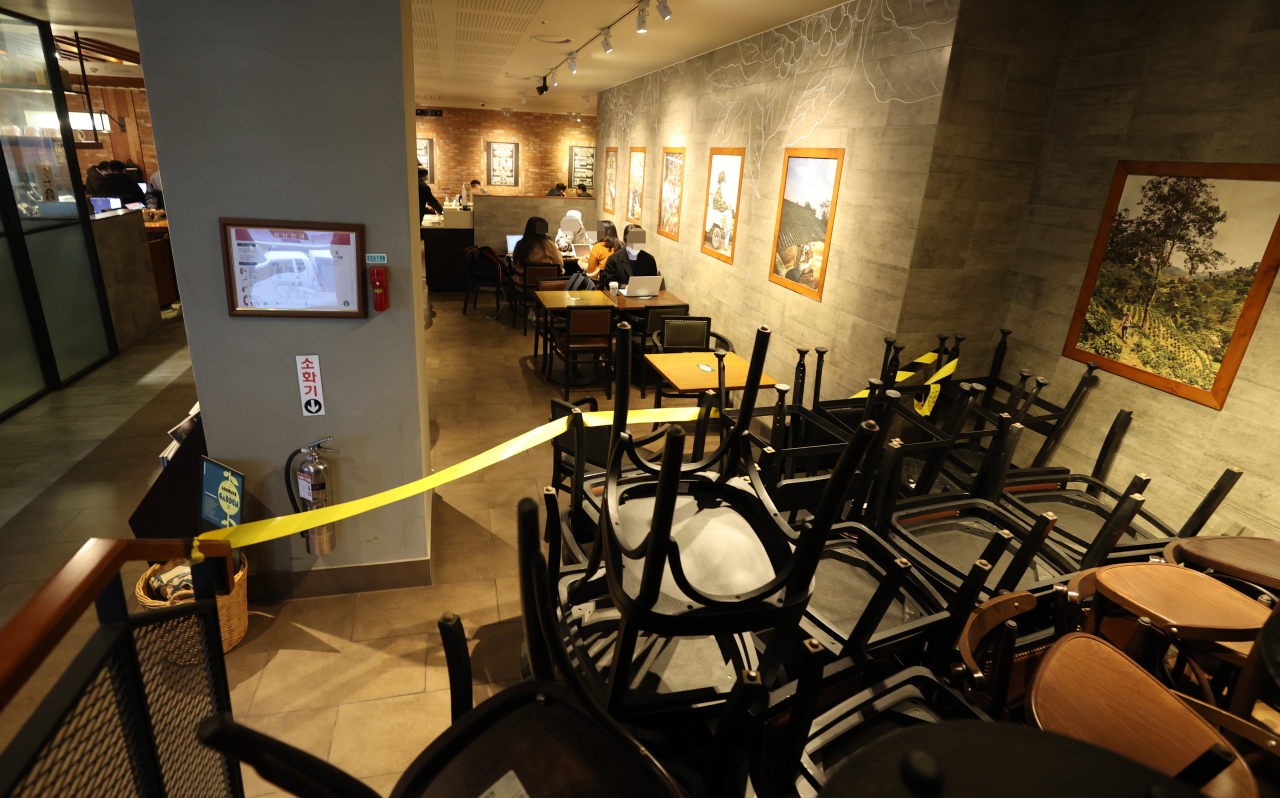Winter phase of coronavirus pandemic may be ‘toughest yet,’ S. Korean experts say

Tables and chairs are stacked up at a corner of a cafe in Seoul on Monday afternoon, as social distancing rules coming into effect Tuesday demands all cafes limit dine-in services. (Yonhap) via The Korea Herald
SEOUL — Experts dread that the latest surge in novel coronavirus infections in South Korea is likely to grow into the “biggest and toughest wave” the nation experiences, as the push for reopening backfires and winter arrives.
Over the weekend, a senior official at Korea Disease Control and Prevention Agency issued a chilling warning: “Korea may be facing the biggest wave of coronavirus infections yet — much worse than the previous waves that hit in the spring and summer.”
Cases have been climbing steadily since the government deserted measures to mitigate the spread in mid-October in favor of economic stability. After the softened social distancing system came into effect two weeks ago, the uptick accelerated to record a streak of 300-plus days for the first time in 81 days. Between Nov. 15 and Saturday, the seven-day average of new local cases more than doubled week over week to around 255.
Health authorities said Sunday they would reinstate tighter social distancing rules for the next 14 days from Tuesday, to rein in the spread in time for another big national event — the yearly college entrance exam known as Suneung, which tens of thousands of high school seniors are expected to take.
There have been 31,004 cumulative confirmed cases of the coronavirus in Korea, and the death toll reached 509 as of Monday. Hospitalizations are rising, with only 52 intensive care unit beds available in the Seoul metropolitan region as of Sunday, Ministry of Health data shows.
Article continues after this advertisementA series of troubling clusters of infections has popped up at hospitals, nursing homes, day care centers and schools, leading to closures and mass quarantines. Health authorities have identified at least 62 such clusters in the past two weeks alone.
Article continues after this advertisementSeoul, home to nearly 10 million people, announced the city would “come to a stop” for a week after its new infections set a record one-day rise of 156 on Friday. Since the initial epidemic in late February in Daegu and North Gyeongsang Province subsided, Seoul has been the epicenter of newly emerging outbreaks. With 7,104 cases to date, the capital is the most affected area in Korea.
Tracking down the coronavirus is harder now that the spread is no longer confined to a particular region or group, according to respiratory disease specialist Dr. Chun Eun-mi of western Seoul’s Ewha Womans University Medical Center.
“Outbreaks that are being reported now are occurring all over without a focal point, rendering them harder to trace and contain,” she said.
The growing share of older patients presents grim possibilities of more patients falling very sick. “Around 1 in 3 patients during the February wave were in their 20s. Whereas recently, patients in their 60s or older make up over a quarter of all cases,” she said.
Winter is also feared to make the pandemic worse.
“Winter is already a challenging season for health care services due to higher incidence of illnesses. It is also when infections caused by respiratory viruses tend to thrive,” she said. “Hospitals will have less room to cope with rise in demand.”
Besides, staying socially distanced will be harder as colder temperatures force people to congregate indoors, she added.
Keeping the health care systems afloat and resilient through the pandemic will be key in avoiding drastic measures, according to another respiratory disease specialist, Dr. Yum Ho-kee of Inje University Paik Hospital in central Seoul.
“To be able to withstand the spread without a lockdown, the incidence of the disease has to be kept at a rate that the health care systems can handle,” he said.
During the initial peak of the coronavirus in Daegu and North Gyeongsang Province, some patients died at home while waiting to be admitted for care.
Yum said imminent bed shortages and medical worker burnout were apparent at the front lines.
“It is estimated around 2 percent of all patients with the coronavirus develop severe symptoms. That translates to six patients requiring critical care for every 300 patients. In other words, if 300 patients are diagnosed each day for two weeks, you’ve got a unit full of seriously ill patients,” he said.
Infectious disease expert Dr. Kim Woo-joo of Korea University Medical Center in Guro, southern Seoul, said efforts to combat the spread should be kept in place until a vaccine or cure is available.
“Our experience with the pandemic so far tells us lifting restrictions prematurely will lead us back to flare-ups. Winter would especially be a bad time for abandoning the mitigation tactics,” he said. “The best strategy in the absence of a vaccine is to endure the restrictions and keep as many people healthy and alive as possible until there is one.”
For more news about the novel coronavirus click here.
What you need to know about Coronavirus.
For more information on COVID-19, call the DOH Hotline: (02) 86517800 local 1149/1150.
The Inquirer Foundation supports our healthcare frontliners and is still accepting cash donations to be deposited at Banco de Oro (BDO) current account #007960018860 or donate through PayMaya using this link.